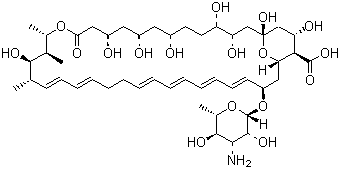
Nystatin
Name: Nystatin
Synonyms: 33-[(3-Amino-3,6-dideoxy-beta-D-mannopyranosyl)oxy]-1,3,4,7,9,11,17,37-octahydroxy-15,16,18-trimethyl-13-oxo-14,39-Dioxabicyclo[33.3.1]nonatriaconta-19,21,25,27,29,31-hexaene-36-carboxylic acid; Fungicidin; Mycostatin
Molecular Structure:
 Molecular Formula: C47H75NO17
Molecular Weight: 926.10
CAS Number: 1400-61-9
EINECS: 215-749-0
Nystatin is a polyene antifungal drug to which many molds and yeast infections are sensitive, including Candida spp. Nystatin has some toxicity associated with it when given intravenously, but it is not absorbed across intact skin or mucous membranes. Nystatin is considered a relatively safe drug for treating oral or gastrointestinal fungal infections.
Cutaneous, vaginal, mucosal and esophageal Candida infections usually respond well to treatment with nystatin. Cryptococcus is also sensitive to nystatin.
Nystatin is often used as prophylaxis in patients who are at risk for fungal infections, such as AIDS patients with a low CD4+ count and patients receiving chemotherapy.
It is prescribed in units, with doses varying from 100,000 (for oral infections) to 1 million (for intestinal ones). As it is not absorbed from the gut, it is safe for oral use and does not have problems of drug interactions.
Nystatin is also used in cellular biology as an inhibitor of the lipid raft-caveolae endocytosis pathway on mammalian cells, at concentrations around 3ug/mL.
Specification: USP26
Packing: 25kg/drum |